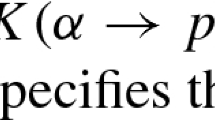Abstract
According to the anti-realistic theory of meaning, everything that is true is knowable. Fitch’s (1963) paradox—based on very standard assumptions made in modal logic—is seen as a challenge to this theory. In this paper I argue that there is something wrong with Fitch’s derivation of the absurdity. Assuming—for the sake of argument— the thesis of anti-realism, I argue with Beall (2000) that this doesn’t lead to disaster in case we allow some contradictions to be true. By making use of a nonmonotonic consequence relation, I show that for all of Tennant’s (1997) so-called ‘Cartesian propositions’ that are true, we can derive that it is true and not false that they are knowable.
I would like to thank two anonymous reviewers for helpful comments and suggestions. This paper builds on joint work with Pablo Cobreros, Paul Egré and Dave Ripley, and I want to thank them as well. This work was done with main support from the Marie Curie Initial Training network ESSENCE-project, and the NWO-sponsored Language in Interaction-project.
Access this chapter
Tax calculation will be finalised at checkout
Purchases are for personal use only
Similar content being viewed by others
Notes
- 1.
van Benthem (2004) argues that Tennant’s limitation is too weak. The thesis of verificationalism should not be limited to propositions that can be known consistently, but rather to propositions that one can learn consistently. Van Benthem observes that there are sentences that can be known consistently, but that cannot be consistently learned: \(\phi = (p \wedge \Diamond \lnot p) \vee \mathbf{K}\lnot p\).
- 2.
- 3.
Notice that the semantics is just like that of Fuzzy Logic, but now limited to three truth values.
- 4.
For a more elaborate discussion of this proposal, see Cobreros et al. (2015).
- 5.
The definition of \(T(\phi )\) is taken from the analysis of minimal truth-makers proposed by van Fraassen (1969).
- 6.
- 7.
\(\phi '\) is a sentence in Negative Normal Form of \(\phi \) if (1) it is logically equivalent with \(\phi \), and (2) negations only stand in front of atomic formulas.
- 8.
‘Thus, if necessity is to be treated syntactically, that is, as a predicate of sentences, as Carnap and Quine have urged, then virtually all of modal logic [...] must be scarified’ (Montague, 1963, p. 9).
- 9.
The thesis could still receive value 1, though, if we used Łucasiewics’ conditional, which is like material implication, except that it assigns to \(\phi \rightarrow \psi \) value 1 if both \(\phi \) and \(\psi \) have value \(\frac{1}{2}\).
- 10.
Recall that \(\models ^{prt}\) is neither transitive (if the language contains a similarity-relation or a transparent truth-predicate) nor does it validate explosion. It is by the latter feature, and not by non-transitivity, that it solves the the knower.
References
Alxatib, S., & Pelletier, F. R. (2011). The psychology of vagueness: Borderline cases and contradictions. Mind and Language, 26, 287–326.
Alxatib, S., Pagin, P., Sauerland, U., et al. (2013). Acceptable contradictions: Pragmatics or semantics? A reply to Cobreros. Journal of Philosophical Logic, 42, 619–634.
Asenjo, F. (1966). Calculus of antinomies. Notre Dame Journal of Formal Logic, 7, 103–105.
Aseno, F., & Tamburino, J. (1975). Logic of antinomies. Notre Dame Journal of Formal Logic, 16, 17–44.
Beall, Jc. (2000). Fitch’s proof, verificationism, and the knower paradox’. Australian Journal of Philosophy, 78(2), 241–247.
Cobreros, P., Egré, P., Ripley, D., & van Rooij, R. (2012). Tolerant, classical, strict. Journal of Philosophical Logic, 41, 347–385.
Cobreros, P., Egré, P., Ripley, D., & van Rooij, R. (2013). Reaching transparent truth. Mind, 122, 841–866.
Cobreros, P., Egré, P., Ripley, D., & van Rooij, R. (2015). Pragmatic interpretations of vague expressions: strong meaning and nonmonotonic consequence. Journal of Philosophical Logic.
Fitch, F. (1963). A logical analysis of some value concepts. The Journal of Symbolic Logic, 28, 135–142.
Grice, H. P. (1967). Logic and conversation. William James Lectures. Harvard University, reprinted in Studies in the Way of Words, 1989. Cambridge, MA: Harvard University Press.
Montague, R. (1963). Syntactic treatment of modality. Acta Philosophica Fennica, 16, 153–167.
Priest, G. (1979). The logic of paradox. Journal of Philosophical Logic, 8, 219–241.
Priest, G. (1991). Minimally inconsistent LP. Studia Logica, 50, 321–331.
Ripley, D. (2011). Contradictions at the borders. In R. Nouwen, R. van Rooij, H.-C. Schmitz, & U. Sauerland (Eds.), Vagueness in communication. Berlin: LICS, Springer.
Ripley, D. (2012). Conservatively extending classical logic with transparent truth. Review of Symbolic Logic, 5, 354–378.
Salerno, J. (Ed.). (2009). New essays on the knowability paradox. Oxford: Oxford University Press.
Serchuk, P., Hargreaves, I., & Zach, R. (2011). Vagueness, logic and use: Four experimental studies on vagueness. Mind and Language, 26, 540–573.
Tennant, N. (1997). The taming of the true. Oxford: Oxford University Press.
van Benthem, J. (2004). What one may come to know. Analysis, 64, 95–105.
van Fraassen, B. (1969). Facts and tautological entailments. Journal of Philosophy, 66, 477–487.
Author information
Authors and Affiliations
Corresponding author
Editor information
Editors and Affiliations
Rights and permissions
Copyright information
© 2017 Springer International Publishing AG
About this chapter
Cite this chapter
van Rooij, R. (2017). Nonmonotonicity and Knowability: As Knowable as Possible. In: Başkent, C., Moss, L., Ramanujam, R. (eds) Rohit Parikh on Logic, Language and Society. Outstanding Contributions to Logic, vol 11. Springer, Cham. https://doi.org/10.1007/978-3-319-47843-2_3
Download citation
DOI: https://doi.org/10.1007/978-3-319-47843-2_3
Published:
Publisher Name: Springer, Cham
Print ISBN: 978-3-319-47842-5
Online ISBN: 978-3-319-47843-2
eBook Packages: Religion and PhilosophyPhilosophy and Religion (R0)




